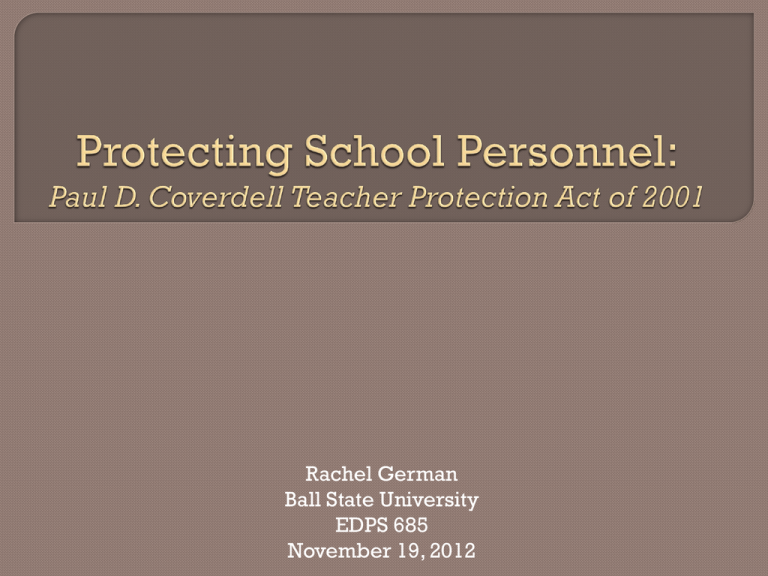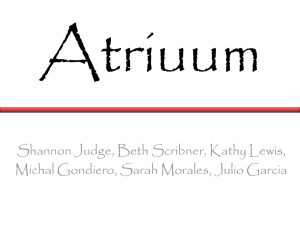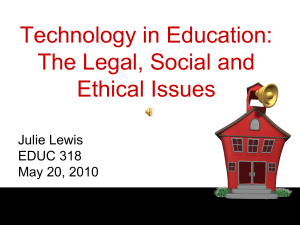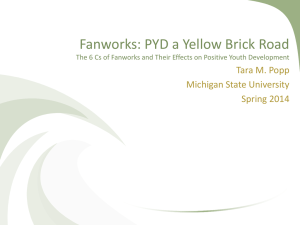Paul D. Coverdell Teacher Protection Act of 2001
advertisement

Rachel German Ball State University EDPS 685 November 19, 2012 1929-2000 Director of United States Peace Corp • 1989-1991 Senator from Georgia • 1993-2000 No Child Left Behind Act Protects against being sued for professional malpractice • When reasonable disciplinary measures used • When trying to create appropriate educational environment • When trying to maintain order Many lawsuits annually • 60% of principals threatened Constant awareness of lawsuits • 82% of teachers have changed way they work • 77% of principals have changed way they work • Not completely bad Act provides some comfort and security Who is covered? • Teacher, principal, administrators • Other educational professionals School psychologists • Member of school board • Other professional or nonprofessional Works in school Must maintain discipline/ensure safety Protected when: • Act within scope of responsibilities • Following law • Trying to maintain classroom/school control • If applicable, properly licensed • Harm not criminal misconduct or disregard for rights or safety of individual • Harm not caused by vehicle Must be upheld to receive NCLB money Punitive damages CANNOT be awarded against teacher if qualifications met • Economic loss • Harm • Noneconomic loss Not historically applied to school psychologists YET Has the potential to have HUGE implications Deal with difficult students • Might need to use discipline to protect student, others, and ourselves Bottom line: As long we use reasonable measures & appropriate discipline, we are protected from lawsuit. High school student’s neck sliced open after being attacked with knife Sued superintendent for negligence • Failed to supervise classmate adequately • Failed to inform school personnel about attacker’s psychiatric & criminal history Court ruled with superintendent • Covered by Coverdell Act • Followed laws Middle school student injured during incidence at the school • Teacher put hand on child’s chest • Student had medical and psychological treatment and physical therapy Court ruled Coverdell Act applied in part • Teacher right to use physical discipline • Took it too far • Had to pay $27,270 Group of students sued boarding school • Claimed personal injuries as result of other students • School personnel present in several instances Court ruled with school • Did not find that there was intent • Acting within scope of responsibility Mother of student with disability sued school personnel for placing child in “quiet room” • Not part of IEP Court ruled with school • Did not violate due process • Reasonable effort to maintain educational environment Bottom line: As long we use reasonable measures & appropriate discipline, we are protected from lawsuit. IDEA and least restrictive environment Often negative media coverage • Controversial Strict guidelines • Agencies create guidelines and offer training programs • Accreditation not required for schools Little research on “prevalence, appropriate applications or efficacy of physical restraint…in school settings” Ryan, Peterson, Tetreault, & K-12 special public school Staff trained extensively Hagen (2007) • “De-escalation” training • How to handle crisis situations • Recognition of behaviors and development of appropriate interventions • Trained in proper use of physical restraints if behavior does escalate Implemented school-wide BIP Data coded from 2 consecutive years: before/after training and BIP Reduction of restraints by 17.6% School psychologists & Coverdell Act • Can help train school personnel to reduce use of physical restraints • Ensure personal training in restraint measures • Implementation of school-wide BIP’s Why If didn’t the turkey eat dessert? April showers bring May flowers, what do May flowers bring? Ashford v. Edmond Public School Dist. 822 F. Supp. 2d 1189. (2011). Retrieved from WestlawNext database. Dydell v. Taylor, 332 S. W. 3d 848. (2011). Retrieved from WestlawNext database. Nkemakolam v. St. John’s Military School. 2012 WL 3583593. (2012). Retrieved from WestlawNext database. Webb v. Clark County School Dist. 125 Nev. 611. (2009). Retrieved from WestlawNext database. Biographical Directory of the United States Congress (2000). Coverdell, Paul: Biographical information. Retrieved from http://bioguide.congress.gov/scripts/biodisplay.pl?index=c000813 DeGenova, J., Davis, L., Gaines, A., Green, P., Hazeltine, B., Jordan, J.W., … Young, P. (2011). Has the threat of lawsuits changed our schools? Education World. Retrieved from http://www.educationworld.com/a_admin/admin/admin371.shtml Jacob, S., Decker, D., & Hartshorne, T.S. (2010). Ethics and Law for School Psychologists (6th ed.) Hoboken, New Jersey: John Wiley and Sons. Rozalski, M. E., Yell, M. L., & Boreson, L. A. (2006). Using seclusion timeout and physical restraint: An analysis of state policy, research, and the law. Journal of Special Education Leadership, 19(2). Retrieved from http://search.proquest.com.proxy.bsu.edu/eric Ryan, J. B., & Peterson, R. L. (2004). Physical restrain in school. Behavioral Disorders, 29(2). Retrieved from http://search.proquest.com.proxy.bsu.edu/eric Ryan, J. B., Peterson, R., Tetreault, G., & Hagen, E.V. (2007). Reducing seclusion timeout and restraint procedures with at-risk youth. Journal of At-Risk Issues, 13(1). Retrieved from http://search.proquest.com.proxy.bsu.edu/eric U.S. Department of Education (2004). Subpart 5: Teacher liability protection. Retrieved from http://www2.ed.gov/policy/elsec/leg/esea02/pg33.html?exp=2









